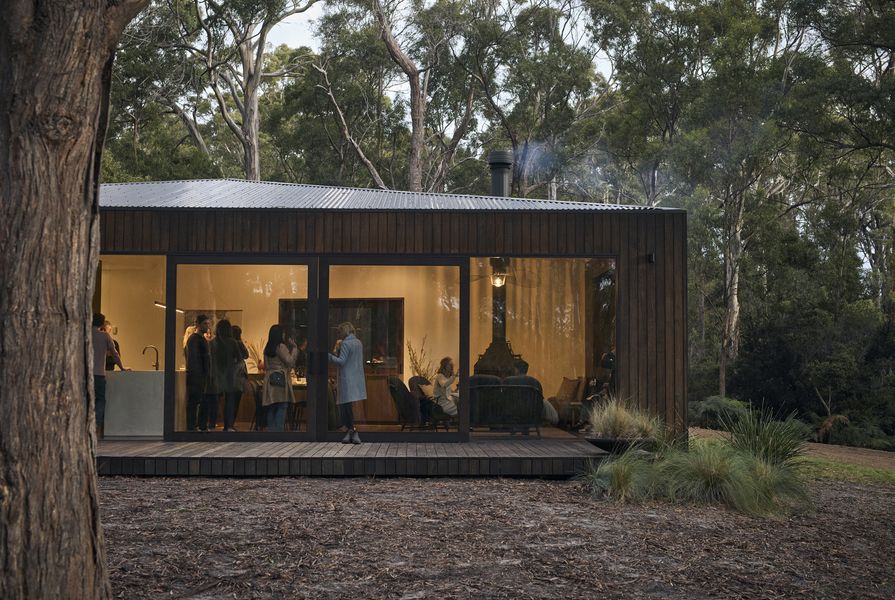The 2022 Australian Institute of Architects Dulux Study Tour was held locally in Australia for the first time in its 14-year history, after two years of stalled tours and the ongoing uncertainty of international borders.
The cohort of promising emerging architects was given the opportunity to explore a curated selection of celebrated sites and practices on their very own doorstep. The two-week tour of Australian destinations covered buildings and landscapes across Tasmania, New South Wales and the Northern Territory.
Below, Madeline Sewall (Breathe Architecture), Tahnee Sullivan (Sullivan Skinner), and Liz Walsh (Cumulus) share their reflections from each section of the tour with ArchitectureAU.
Madeline Sewall in Captain Kelly’s Cottage by John Wardle.
Image: Rémi Chauvin
Madeline Sewell – Tasmania
Tasmania is a place that has always drawn me in – the pristine wilderness and atmospheric weather combine in an enchanting and amorphous landscape that feels deeply nurturing and almost sacred. The specialness of this place is something inherently felt by the whole group, and a clear point of pride for those who call it home. A deep sense of appreciation for the environment seems to feed into all aspects of life in Tasmania and this was palpable in the projects we visited.
Though diverse in typology and execution, all of the projects visited demonstrated a significant respect and understanding of the landscape and the environment in which they were situated. Sited on some of Australia’s most rugged and exposed coastlines, we saw projects that balanced the capture of views and amenity with resilient design to withstand Tasmania’s harsh conditions.
Core Collective’s Sunnybanks House is a commendable example of this, achieving a 9-star Nationwide House Energy Rating Scheme (NatHERS) rating by balancing strategic but generous views of forested surrounds with high-performance triple glazing and thermally broken window detailing. The house demonstrated a sincere commitment to sustainability, to the extent that founding director Ryan Strating collaborated with a European manufacturing company to develop and import an expanded clay aggregate for use as insulative, lightweight growing media for the building’s green roof. Hearing him describe this process of research and development was a powerful reminder that we as architects have the skills and expertise to influence the built environment well beyond individual projects, and arguably have a responsibility to do so.
The tour prompted many conversations and reflections, but for me, one of the biggest takeaways was the importance of resource management in the practice of architecture. At Breathe, we care deeply about the environment and consider the management of embodied and operational energy on each project we work on. But something the tour gave me perspective on is how various architects manage the resources of time and personal energy. We saw some exquisitely executed details on the tour – precision tile set-outs, bespoke door hardware, the perfect custom flush buttons. In seeing these things I have respect for the thought it took to craft them, but for me, it reconfirmed that I want to be an architect that uses my time and personal energy not just to make something beautiful, but to have a real impact. Impact not just on the residents, the visitors, or even the immediate community, but on the planet at large.
To build a better future in the context of climate change, every resource matters. As architects, we are in a powerful position to affect change on one of the largest contributors to global warming if we use our planet’s resources and personal resources thoughtfully. For me, the tour was a reminder of how critical this is and how creatively it can be done. Seeing so many strategic and skilful examples across three very different climate zones was heartening and certainly worth celebrating.
Tahnee Sullivan on the Dulux Study Tour, Sydney.
Image: Alexander Mayes
Tahnee Sullivan – Sydney
The Sydney leg of the Australian Institute of Architects Dulux Study tour spanned four days, encompassing civic projects, a suite of practice visits, and tours of private residences - the majority of which were architects’ own homes.
The practice visits to Smart Design Studio, Durbach Block Jaggers, Renato D’Ettorre Architects and Welsh and Major Architects afforded a rare insight into the inner workings of small and large practice and allowed us to share in candid conversations with esteemed Australian architects. The convergence of multiple practice visits over such a short period highlighted a range of approaches or positions relating to design process, practice, studio culture, and prompted reflection on the architectural profession more broadly.
The residential project visits offered the opportunity to visit some remarkable homes, typically inaccessible to the public. The homes of architects William Smart, Adam Haddow and Conrad Johnston were each compact and cleverly designed to suit the specific lifestyle of the occupants, demonstrating the wonderful outcomes which result from an open-minded, innovative approach to the resolution of design problems coupled with an unwavering commitment to the architectural intent.
In these architects’ own homes, we see creative liberties taken which may not otherwise be explored in client projects. This is not to diminish the beautifully resolved Glebe House by Chenchow Little, which meets all the descriptors I’ve ascribed to the architect’s homes we visited. It is clear that this home is adored by, and unequivocally designed for, its occupants: a testament to the client-architect relationship, which in Tony Chenchow’s words, is paramount.
There was so much to learn from our time in Sydney, however a primary takeaway from the practice and project visits, and the subsequent conversations amongst ourselves, was the value of building relationships with peers, mentors and clients. Throughout the tour we benefited from an overarching willingness to share knowledge and offer support or guidance when asked. A reminder that those in small practice, such as myself, can still share in the expertise and knowledge of respected senior architects and a greater collective.
George Brown Botanic Gardens Visitor and Events Centre by Architect Hully Liveris.
Image: Bek Verrier
Liz Walsh – Darwin
The last leg of our Dulux Study tour was spent in the Northern Territory: two days in Darwin and two days in the Kakadu National Park. Both experiences were extremely moving – in Darwin we observed a kind of gloves-off approach to architecture, while in the Kakadu we witness Aboriginal community groups continuing to practice their culture on their country as they have done for thousands of years.
I found there was an honesty, a rawness, an acceptance of the human condition that defines the tropical architecture of Beni Burnett and Troppo Architects. Nothing is closeted or hidden away: in fact, even the walls don’t quite go up to the ceiling. Fridges are not concealed in joinery, laundries spill out and over into carports and there isn’t a glimpse of a butler’s pantry, a powder room or a slab of Carrara marble to be seen.
It’s a breath of un-air-conditioned fresh air. The architecture is colourful and quirky; there is something inclusive, flexible, accessible and responsible about Burnett’s and Troppo’s architecture that calls into question every “eco brass tap” I have specified and makes me wonder if, in a time of climate crisis and increasing homelessness, servicing the top five percent of the residential market is enough.
On our last day we visited the Ubirr rock art site in Kakadu National Park. The visit provided the perfect bookend to our first day of the tour which was spent exploring krakani lumi standing camp located in wukalina/Mt William National Park, Tasmania. From the bottom to the top and the start to the finish there was a poetic symmetry to our tour that spoke to a desire for a deeper understanding of place. From the outset, our tour had the unique opportunity to examine how country (land, sea and sky), culture, climate and community can conceptually challenge and perhaps even disrupt architecture. The tour shifted my thinking away from the objectification of architecture, away from buildings, that more often than not, sit intentionally at odds with their context, so desirous is their need to claim the spotlight, towards an architecture that sits quietly often in the background, allowing for, accommodating and sheltering in the most elemental sense of the words.
To read more about the 2022 Dulux Study Tour, visit the blog on the Australian Institute of Architects website.
The 2021 winners were: Carly Martin, Simon Rochowski, Nick Roberts, Madeline Sewall and Elizabeth Walsh. The 2020 winners were: Ksenia Totoeva, Sam McQueeney, Tahnee Sullivan, Keith Westbrook and Bek Verrier.

















































